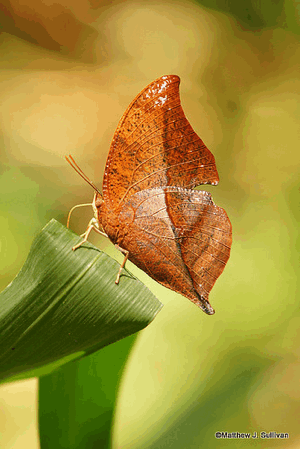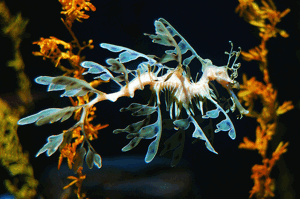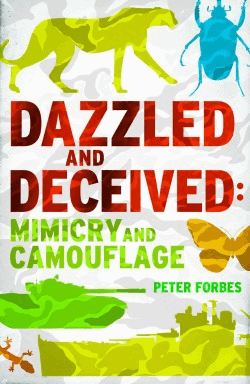The Battle to Blend in
Air Date: Week of February 19, 2010

A leaf mimic butterfly.
Scientists have long been intrigued by mimicry. Mimics adopt other animals’ colors to ward off predators, or take on the color and shape of their surroundings to avoid being seen. Artists have also noticed animals’ impressive disguises. Peter Forbes, author of the new book, Dazzled and Deceived: Mimicry and Camouflage, tells host Jeff Young how both artists and scientists tried to convince British military officials to adopt camouflage by disguising armies and battleships with tried and true methods from the natural world.
Transcript
YOUNG: Now the scaly-foot snail’s not the only creature to inspire the military-minded. The Romans observed the tortoise and created the testudo – an ingenious method of overlapping shields to block incoming arrows and such.
Camouflage and mimicry in nature have long amazed and at times frustrated humans. Just how did the leaf like mantis or walking stick gain the ability to disappear before our eyes? And how does a benign butterfly manage to imitate its toxic cousins? Peter Forbes dives into those questions in his book “Dazzled and Deceived: Mimicry and Camouflage”. It’s a thorough history of the scientists and soldiers who tried to understand and apply some of nature’s best tricks. Hello, Mr. Forbes!
FORBES: Hi there.
YOUNG: So why mimicry and camouflage, what drew you to this subject?

A leaf mimic butterfly.
FORBES: Well the great thing about mimicry is that I mean sometimes in evolution you see some weird creature and you think, how did that evolve or why? But with mimicry the fact is you’ve got two things that look the same, so you see what must have happened; they gained some advantage that they hide that way. So in a sense they’re like artists, they see a pretty pattern and copying it.
YOUNG: This is a real challenge for evolutionary theory to explain how these things came to be.
FORBES: Well, it’s a challenge that it’s still running this challenge actually because there’s a lot of debate about the mechanisms of evolution, not about that it happened, but how does one creature get to look like another? You can see if one creature looks quite a lot like another and one creature’s dangerous, so predators leave it alone – the one that looks a bit like the other one will get to look more like it because the one’s that aren’t very good mimics will get picked up by predators. But the big problem is how does it start? And actually Darwin wrote his book 150 years ago and biologists are still arguing about exactly how does it start?
YOUNG: You know, I had one of these moments recently at the aquarium here in Boston with my daughter – we’re looking at the leafy sea dragon and I’m looking at that thing with all its baroque appendages and it’s such a perfect match and you just think, you can easily slip into this – gee, there must have been a design kind of thinking to that, and a lot of scientists fell into that trap. I noticed that throughout your book.

The leafy sea dragon. (Wikimedia Commons)
FORBES: Well, I don’t think – I’m glad you saw the leafy sea dragon, it’s one of my favorites, but I mean it really does look like seaweed. But I mean, why would anything get designed to look like seaweed? And the actual designer really is a seaweed and the dragon lives among them – I mean it is a predator, so it needs to hide so that the things that it eats can’t see it.
YOUNG: So this debate was kind of raging in science about the mechanisms that would produce mimicry and camouflage in animals, and then along come World War I and these scientists felt compelled, I guess to offer what they had learned from nature for the war effort?
FORBES: Yes, in the 1890s Albert Thayer and American artist and naturalist formulated some ideas about camouflage – counter-shading – and he communicated these ideas to some biologists in England. So when war started in 1914, they tried to tell the war department that in modern warfare you’re going to need camouflage, the weapons are bigger and stronger.
I mean in the old days, soldiers used to go into battle wearing red so that they could be identified, but once you got the machine gun this wasn’t a very good idea when you’ve got a machine gun firing at you. You need to hide, you need to hide your troops, and you need to hide your ships, you need to try to hide everything.
YOUNG: And was Mr. Thayer persuasive?
FORBES: Well, Thayer was an amazing character. He’s one of the central figures in my book, but Thayer was obsessed. He was obsessed that ships had to have all kinds of crazy ideas to camouflage them. In fact, he even suggested rigging them out so that they looked like clouds on the horizon, things like that. But unfortunately, in the first World War mostly the authorities didn’t listen to the naturalists, they actually did listen to an artist though.
YOUNG: So the naturalists were bringing what they thought were the best ideas for camouflage, but artists had their own ideas. How did that play out?
FORBES: There’s this story: Gertrude Stein was with Picasso when the war started and they saw some camouflage tanks coming down the street and Picasso said, “Cubism! That is cubism – we made that. We made camouflage.” Now, it wasn’t quite as simple as that, but there were painters in the French camouflage corps who were quite clearly influenced by cubism.

And in fact, more artists were involved early in the camouflage effort than naturalists. And the naturalists got rather aggrieved because they thought, look we discovered this first, we know how creatures who life – it’s life and death for them, whether they escape a predator, therefore, it must be relevant to human warfare. But the painters said, look we know all about how to break up forms and to hide things, we’re the experts in visual world, so trust us. So it was a kind of battle that went on between artists and naturalists.
YOUNG: And who won there in the World War I year?
FORBES: Well, in World War I, I guess you have to say that the artists won because an English artist called Norma Wilkinson came up with this idea of dazzle painting, which rather turned ships into kind of zebras. And this wasn’t to hide them because you said you can’t hide ships on the sea. It was to create a confusing jangle to confuse the range finders of periscopes of the submarines that were hunting them.
YOUNG: Did it end up doing any good – did it save boats from getting hit by u-boat torpedoes?
FORBES: I mean one month you’d see that the death of ships seemed to have a much better survival rate, then the next month you’d see it didn’t seem to be true. And actually when the war was over the navy authorities said in the future we won’t do dazzle. But as I say, although they started the second World War with grey ships, camouflage had started to come back again, but this time it was really the – it wasn’t dazzle – it actually was the naturalist’s idea of using soft tones and trying to counter the effect of light and shadow.
YOUNG: So the influence of naturalists in camouflage they really reached their peak in the desert in World War II?
FORBES: So, I think that battle in the desert, which is fantastically improvised, and of course it’s very hard to hide in the desert, this was the thing – you couldn’t really hide, but you could make one thing look like another. The Battle of El Alamein was a massive deception operation where they actually disguised the tanks as trucks.

Author Peter Forbes.
They actually created a dummy army in a place where they weren’t going to attack, they created a rail head, which was just made out of palm fronds, they put up dummy flares to attract the planes to this dummy railhead. You know, they even had locomotive that was smoking with dummy men around it. They used every trick in the book. That’s the high point of that kind of huge, huge scale camouflage that could only happen before the modern electronic era of warfare.
YOUNG: And the guy who was the main force behind this, very interesting guy, Cot. Is that his name?
FORBES: Yes, Hugh Cot was really the man in camouflage military, the naturalist in the mid-20th century. He wrote the classic book, which is still unsurpassed really. The strange thing is he joined the military and became a camouflage instructor and went to the desert and it must be the only big natural history tome that was ever packed into soldiers’ kit bags because it was the recommended reading that you had to learn from nature if you’re going to be a desert camouflor.
YOUNG: So you actually had soldiers carrying around this natural history textbook with them?
FORBES: Absolutely, and it’s quite a big book, yeah.
YOUNG: But it paid off because Montgomery was able to fool the desert fox, Rommel.
FORBES: Absolutely, yes. Churchill, himself, was very, very keen on camouflage activities, so the British approach was to actually use as much of this kind of deception as possible. And Hugh Cot was there as the brains behind the training of the camouflors in the desert.
YOUNG: You know, it’s pretty ironic here that the whole point of mimicry and camouflage is so that you can’t see it. And yet, by looking at it closely, we’ve gained great insight for decades and decades.
FORBES: Well, yes, absolutely. I mean, the whole business of trying to hide, or trying to be so like another creature that you get a quiet life because that creature’s so dangerous cause things leave it alone. And, yeah, by trying to hide some how or other, it’s a technique that for us we look at creatures that do this and we think, ah ha! This can tell us a lot about how nature works.
YOUNG: Well the book is jut fascinating. It’s called “Dazzled and Deceived: Mimicry and Camouflage”, Peter Forbes, thanks very much.
FORBES: Thank you.
Links
Living on Earth wants to hear from you!
Living on Earth
62 Calef Highway, Suite 212
Lee, NH 03861
Telephone: 617-287-4121
E-mail: comments@loe.org
Newsletter [Click here]
Donate to Living on Earth!
Living on Earth is an independent media program and relies entirely on contributions from listeners and institutions supporting public service. Please donate now to preserve an independent environmental voice.
NewsletterLiving on Earth offers a weekly delivery of the show's rundown to your mailbox. Sign up for our newsletter today!
 Sailors For The Sea: Be the change you want to sea.
Sailors For The Sea: Be the change you want to sea.
 The Grantham Foundation for the Protection of the Environment: Committed to protecting and improving the health of the global environment.
The Grantham Foundation for the Protection of the Environment: Committed to protecting and improving the health of the global environment.
 Contribute to Living on Earth and receive, as our gift to you, an archival print of one of Mark Seth Lender's extraordinary wildlife photographs. Follow the link to see Mark's current collection of photographs.
Contribute to Living on Earth and receive, as our gift to you, an archival print of one of Mark Seth Lender's extraordinary wildlife photographs. Follow the link to see Mark's current collection of photographs.
 Buy a signed copy of Mark Seth Lender's book Smeagull the Seagull & support Living on Earth
Buy a signed copy of Mark Seth Lender's book Smeagull the Seagull & support Living on Earth

